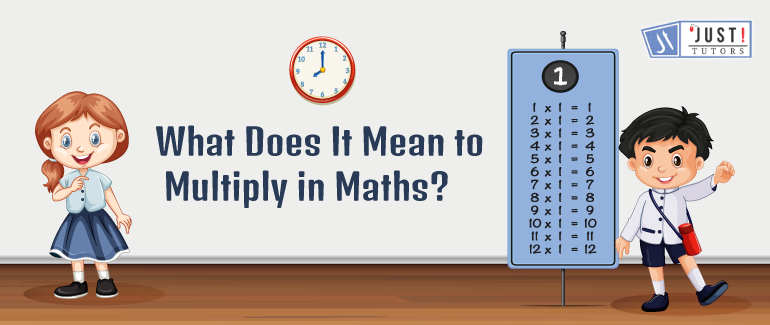Your child must be able to count and add numbers before learning the meaning of multiplication.
We normally think of the Times Tables when we think of multiplication. You should not teach your child the Times Tables until he or she understands how to multiply two numbers, in my opinion.
Once your youngster grasps the concept, the Times Tables can be used as a shortcut to completing the computations.
Your youngster will be able to face the complex problem sums found in tests and exams if they understand the concept.
Adding numbers in groups
Multiplying numbers is essentially the same as adding groups of numbers.
For example, if we have three groups of five balls and need to calculate the total number of balls, we can do one of the following:

(3 ball groupings x 5)
Alternatively, we might divide the number of groups by the number of balls in each group.
(5 + 5 + 5)within the clusters, place the balls
3 x 5 = 5 + 5 + 5 = 5 + 5 + 5 = 5 + 5 + 5 = 5 + 5 + 5 = 5 + 5 + 5 = (3 sets of 5)
Multiplying is the process of adding numbers again and over again. (The numbers must all be the same before multiplying.)
Learning the Times Tables makes sense when you think of it this way.
For example, the three times tables. This is how most students learn the three times tables:
1 × 3 = 3
3 × 2 = 6
3 × 3 = 9
and so forth.
Using the concept of sets/groups, we have:
3 = 1 × 3 (1 set of 3)
3 + 3 = 6 = 2 × 3 (2 sets of 3)
3 + 3 + 3 = 9 (3 sets of 3)
and so forth.
So, if your youngster knows the solution to 3 × 4 is 12, but not to 4 × 4, they may just add 4 to 12 to get the answer.
12 + 4 = 4 × 4
Class 3 Mathematics Practice Questions MCQ with Answers
- Chapter: 1 Shapes And Design
- Chapter: 2 Fun With Numbers
- Chapter : 3 Give And Take
- Chapter: 4 How Many Times
- Chapter: 5 Rupees And Paise
- Chapter: 6 Long And Short
- Chapter: 7 Who Is Heavier
- Chapter: 8 Jugs And Mugs
- Chapter: 9 Play With Pattern
- Chapter: 10 Where To Look From
- Chapter: 11 Fun with give and take
- Chapter: 12 Can We Share
- Chapter: 13 Time Goes On
- Chapter: 14 Fractions
- Chapter: 15 Handling Data
Terms in multiplication
There is a Multiplier and a Multiplicand when we multiply.
A multiplier is a number that indicates how many groups there are.
The number within each group is the multiplicand.
The answer we get after multiplying is called the product.
2 × 7 denotes two groups of seven or seven plus seven. As a result, the multiplier is 2. The multiplicand is number seven.
2 × 7 = 14, hence the Product of 2 × 7 is 14.
Multiplication as repeated addition
Multiplication should be taught as repeated addition. Some Math teachers believe this is the ideal approach to look about multiplication, but the first method is found to be easier for most children to grasp. After they’ve grasped the concept of grouping, teach them about repeated addition.
You must still add groups of numbers in repeated addition.
For example, 7 × 3 denotes multiplying the number 7 by three.
7 × 3 = 7 + 7 + 7 = 21
This strategy would look like this if we used it to memorise the Times Table:
Table of 3
1 × 3 = 1 + 1 + 1 = 3 (add the number 1, 3 times)
2 × 3 = 2 + 2 + 2 = 6 (add the number 2, 3 times)
3 × 3 = 3 + 3 + 3 = 9 (add the number 3, 3 times)
and so forth.
The following method makes more sense if your youngster has to learn multiplication tables via repeated addition.
Table of 3
3 × 1 = 3 (number 3 added 1 time)
3 × 2 = 3 + 3 (number 3 added 2 times)
3 × 3 = 3 + 3 + 3 (number 3 added 3 times)
3 × 4 = 3 + 3 + 3 + 3 (number 3 added 4 times)
and so forth.
In repeated addition,
3 × 7 means 3 + 3 + 3 + 3 + 3 + 3 + 3
so, 3 is called the multiplicand and 7 is called the multiplier.
In 3 × 7 = 21, Hence, 21 is called the product.
Multiplication by drawing models
You can move on to drawing models once your child has mastered using tangible objects.
| 6 | 6 | 6 |
3 groups of 6
6+6+6
3 × 6
When drawing multiplication models, keep the following in mind:
For the same number, the box sizes must be the same.
The box for a larger number should be larger than the box for a lower number.
The boxes are commonly drawn in a row horizontally.
Multiply by 10 using place value
3 × 10
| Thousands | Hundreds | Tens
3 |
Ones
0 |
Each digit becomes 10 times bigger so it moves into the next place value.
31 × 10
| Thousands | Hundreds
3 |
Tens
1 |
Ones
0 |

